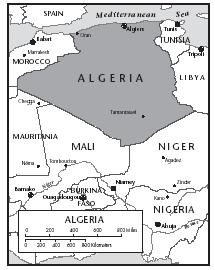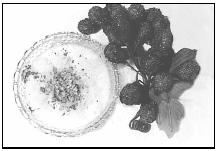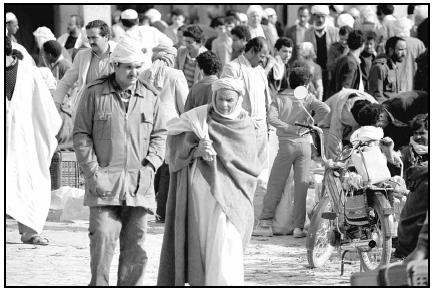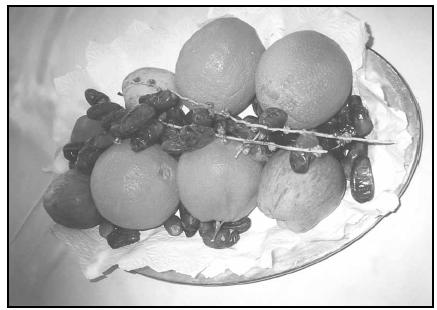Algeria
Recipes

1 GEOGRAPHIC SETTING AND ENVIRONMENT
Algeria is located in North Africa on the Mediterranean Sea. The fertile and mountainous northern region is home to the olive tree, cork oak, and vast evergreen forests where boars and jackals roam. Fig, agave, and various palm trees grow in the warmer areas. The grape vine is native to the coastal plain. Central Algeria consists of the High Plateaus that contain salt marshes and dry or shallow salt lakes. The land becomes more arid (dry) the farther south one travels, eventually becoming the Sahara Desert. Roughly 80 percent of the country is desert, where vegetation is sparse. Camels are widely used in this arid region, although jackals, rabbits, scorpions, and snakes also occupy the deserts.
The coastal region has a typical Mediterranean climate—pleasant nearly year round, with winter temperatures rarely falling below freezing (32°F). Rainfall is also abundant along the coast. Farther inland, higher altitudes receive considerable frost and occasional snow. Little or no rainfall occurs throughout the summer months in this region. In the Sahara Desert, rainfall is unpredictable and unevenly distributed.
2 HISTORY AND FOOD
Algerian cuisine traces its roots to various countries and ancient cultures that once ruled, visited, or traded with the country. Berber tribesmen were one of the country's earliest inhabitants. Their arrival, which may extend as far back as 30,000 B.C., marked the beginning of wheat cultivation, smen (aged, cooked butter), and fruit consumption, such as dates. The introduction of semolina wheat by the Carthaginians (who occupied much of northern Africa) led the

Muslim Arabs invaded Algeria in the 600s, bringing exotic spices such as saffron, nutmeg, ginger, cloves, and cinnamon from the Spice Islands of eastern Indonesia. They also introduced the Islamic religion to the Berbers. Islam continues to influence almost every aspect of an Algerian's life, including the diet.
Olives (and olive oil) and fruits such as oranges, plums, and peaches were brought across the Mediterranean from Spain during an invasion in the 1500s. Sweet pastries from the Turkish Ottomans and tea from European traders also made their way into Algerian cuisine around this time.
In the early 1800s, Algerians were driven off their own lands and forced to surrender their crops and farmland to the French. The French introduced their diet and culture to the Algerians, including their well-known loaves of bread and the establishment of sidewalk cafés. This French legacy remains evident in Algerian culture. In fact, Algeria's second language is French. (Arabic is the official language.)
Tomatoes, potatoes, zucchini, and chilies, significant to Algerian local cuisine, were brought over from the New World.
Saffron and Raisin Couscous with Fresh Mint
Ingredients
- 2 cups water
- ½ teaspoon saffron
- 1 teaspoon extra virgin olive oil
- ½ teaspoon salt
- 2 cups couscous
- ¼ cup raisins
- 3 Tablespoons fresh mint, chopped
Procedure
- In a saucepan, bring the 2 cups of water to a boil and add the saffron.
- Remove from the heat, cover, and let stand for 30 minutes.
- Return the pan to the heat, return to a boil, and mix in the olive oil, salt, couscous, and raisins.
- Remove from the heat, cover, and let stand for 30 minutes.
- Top with the fresh mint.
Makes 8 servings.
Fresh Sweet Dates
Ingredients
- 1 pound fresh dates
- ½ cup butter
- ¾ cup flour
- 1 teaspoon cardamom, ground
Procedure
- Remove the pits from the dates and arrange in 6 individual serving dishes.
- Melt the butter in a heavy saucepan and stir in the flour.
- Cook over medium heat, stirring constantly, until the flour turns golden brown. Be careful not to burn.
- Remove the flour mixture from the heat and stir in the cardamom.
- Remove from heat and allow to cool slightly, stirring occasionally.
- While still warm, pour over the warm dates and allow to cool to room temperature before serving.
Makes 6 servings.
3 FOODS OF THE ALGERIANS
Traditional Algerian cuisine, a colorful combination of Berber, Turkish, French, and Arab tastes, can be either extremely mild or packed with flavorful seasonings. Ginger, saffron, onion, garlic, coriander, cumin, cinnamon, parsley, and mint are essential in any Algerian pantry.
Couscous , the national dish, is often mistaken as a grain itself, rather than pasta. The pasta dough is a mixture of water and coarse, grainy semolina wheat particles. The dough is then crumbled through a sieve to create tiny pellets. Algerians prefer lamb, chicken, or fish to be placed on a bed of warm couscous, along with cooked vegetables such as carrots, chickpeas, and tomatoes, and spicy stews. Couscous can also be used in desserts by adding a variety of ingredients, such as cinnamon, nutmeg, dates, and figs.
No Algerian meal would be complete without bread, normally a long, French loaf. Similar to Middle Eastern customs, bread is often used to scoop food off of a plate or to soak up a spicy sauce or stew. More traditional Berber families usually eat flat, wheat bread.
Mechoui , a roasted whole lamb cooked on an outdoor spit, is usually prepared when a large group of people gathers together. The animal is seasoned with herb butter so the skin is crispy and the meat inside is tender and juicy. Bread and various dried fruits and vegetables, including dates (whose trees can thrive in the country's Sahara desert), often accompany mechoui .
Beverages such as mint tea are a favorite among all North African countries. Tea is usually offered to visiting guests, though coffee flavored with cardamom is another option. With the abundance of fruits year round, fresh juices are plentiful and children tend to favor apricot nectar. Sharbats , fruit or nut-flavored milk drinks, are popular with all ages, including sahlab , a sweet, milky drink. Traditional Berbers, in particular, prefer drinks made from goat milk, although cow milk is now available. Basbousa (Egyptian semolina cake), tamina (roasted semolina with butter and honey), and sweetened couscous are just a few sweets enjoyed by the Algerians.
Etzai (Mint Tea)
Ingredients
- 1½ Tablespoons green tea
- Boiling water
- 3 Tablespoons sugar, or to taste
- Handful of fresh mint leaves
Procedure
- Put the tea in a teapot.
- Pour in a cupful of boiling water, then immediately pour it out again. This is to wash the leaves.
- Add the sugar to taste, then the mint leaves.
- Pour in boiling water 12 inches away from the top (this oxygenates the tea) and stir well. Be extremely careful not to splash the boiling water.
- Serve the tea very hot, again pouring it from a height of about 12 inches.
Sahlab
Ingredients
- 3 cups (8 ounces each) milk
- 1 cup sugar
- ½ cup cornstarch
- ¾ cup water
- ¼ cup raisins
- ¼ cup coconut
- ¼ cup walnuts or pistachios, chopped
- 1 teaspoon cinnamon
Procedure
- In a small mixing bowl, dissolve the cornstarch in the water and set aside.
- In a heavy saucepan, bring the milk to a boil over low to medium heat.
- As soon as the milk boils, reduce the heat.
- Stir in the sugar, and allow the milk to simmer until the sugar has dissolved (no more than 1 minute).
- Slowly pour the cornstarch mixture into the milk, making sure to whisk rapidly to prevent the milk from sticking to the bottom of the saucepan. The milk will gradually thicken.
- When it reaches the consistency of a thick gravy, remove from heat.
- Pour sahlab into decorative small bowls, glasses, or mugs.
- Sprinkle with raisins, coconut, chopped nuts, and cinnamon, if desired.
- Serve hot.
Makes 6 servings.

Banadura Salata B'Kizbara (Tomato and Coriander Salad)
Ingredients
- ½ cup fresh coriander leaves, chopped
- 1 small hot chili pepper, seeded and finely chopped
- 5 medium ripe tomatoes, peeled
- 4 Tablespoons fresh lemon juice
- ¼ cup virgin olive oil
- 1 teaspoon salt
Procedure
- Slice the peeled tomatoes and place in a bowl.
- Sprinkle the chopped coriander over the tomatoes.
- Mix the chopped chili pepper with the lemon juice and 1 teaspoon of salt.
- Beat the olive oil into the chili-lemon juice mixture.
- Pour over the tomatoes and coriander.
- Let rest 15 minutes before serving.
Makes 6 servings.
Sweet Couscous Dessert
Ingredients
- 1 cup plus 2 Tablespoons couscous
- ⅔ cup warm water
- ⅔ cup fresh dates
- ⅔ cup ready-to-eat prunes
- 6 Tablespoons butter, melted
- ¼ cup sugar
- 1 teaspoon cinnamon, ground
- ½ teaspoon nutmeg, ground
- Rose petals, to decorate (optional)
Procedure
- Place the couscous in a bowl and cover with ⅔ cup warm water.
- Leave 15 minutes to plump up.
- Halve each date lengthwise, remove the seed and cut into 4 pieces.
- Roughly chop the prunes.
- Fluff up the grains of couscous with a fork, then place in a cheesecloth-lined sieve and steam over simmering water for 15 minutes until hot.
- Transfer to a bowl and fluff up again with a fork.
- Add the melted butter, sugar, dates, and prunes.
- Pile the couscous into a cone shape in a serving dish.
- Mix the cinnamon and nutmeg together and sprinkle over couscous.
- Serve decorated with rose petals, if desired.
Makes 4 servings.
4 FOOD FOR RELIGIOUS AND HOLIDAY CELEBRATIONS
The overwhelming majority of Algerians, about 99 percent, follow the beliefs of Islam, the country's official religion (Christians and Jews make up only 1 percent of the population).
The Algerian observance of Ramadan, the ninth month of the Islamic year (most often November or December), is the most celebrated of all holidays. During the monthlong observance, Muslims are required to fast (avoid consuming food and drink) between sunrise and sunset, although young, growing children and pregnant women may be allowed to eat a small amount. At the end of each day during Ramadan, sometimes as late as midnight, families join together for a feast. French loaves or wheat bread and a pot of hot mint tea will likely serve as refreshments.
The meal marking the end of Ramadan, Eid al-Fitr , is the most important feast. It almost always begins with soup or stew. Lamb or beef is most often served as the main dish, although families living close to the Mediterranean in northern Algeria enjoy a variety of seafood. In most Algerian homes, a bowl of fresh fruit is placed on the table at the end of the meal. Traditionally, each person is responsible for peeling and slicing his or her own fruit. However, on special occasions such as Eid al-Fitr , the host will often serve the fruit already peeled, sliced, and flavored (most often with cinnamon and various citrus juices).
Other popular holiday celebrations are Labor Day (May 1), and the anniversary of the revolution over French control (November 1). Two local festivals that are celebrated every spring are the cherry moussem (festival) in Tlemcen and the tomato moussem in Adrar.
A Typical Holiday Menu
Cucumber and yogurt soup
Stuffed dates and walnuts
Roast stuffed leg of lamb
Tomato and raisin-stuffed eggplant
Potato & chickpea salad
Cooked carrots
Fresh fruit medley
Stuffed Dates and Walnuts
Ingredients
- 12 fresh dates
- ½ cup ground almonds
- 2 Tablespoons pistachio nuts, very finely chopped
- 2 Tablespoons granulated sugar
- Orange flower water (found at specialty stores)
- 24 walnut halves
- Powdered sugar, to decorate
Procedure
- With a sharp knife, make a slit down the length of each date and carefully remove the seed.
- In a bowl, mix together the ground almonds, chopped pistachio nuts, and granulated sugar.
- Add enough orange flower water to make a smooth paste.
- Shape half of the paste into 12 nuggets the size of date seeds and use to stuff the dates.
- Use the remaining paste to sandwich the walnut halves together in pairs.
- Sift a little powdered sugar over the stuffed dates and walnuts. Serves best with rich coffee.
Makes 4 to 6 servings.

Algerian Cooked Carrot Salad
Ingredients
- 1 pound carrots
- 3 garlic cloves, chopped
- Pinch of salt
- Pinch of sugar
- Lemon juice
- ¼ teaspoon salt
- ½ teaspoon cayenne pepper
- ¼ teaspoon cumin
- Parsley, chopped
Procedure
- Scrape the carrots and cut them into four pieces lengthwise.
- Cook in a little water with garlic and a pinch of salt and sugar for 15 minutes.
- Drain and chill the carrots.
- Just before serving, cover with lemon juice, about ¼ teaspoon of salt, cayenne pepper, and cumin.
- Sprinkle with chopped parsley.
Makes 6 servings.
Chlada Fakya (Fresh Fruit Medley)
Ingredients
- ½ cantaloupe, peeled, seeded, cut into bite-sized pieces
- ½ honeydew melon, peeled, seeded, cut into bite-sized pieces
- 1 cup strawberries, cut in half, stemmed, washed
- 2 bananas, peeled and thinly sliced
- 5 seedless oranges, peeled and thinly sliced
- ½ cup orange juice
- Juice of 2 lemons
- 2 Tablespoons sugar
- 1 teaspoon vanilla extract
- 1 teaspoon cinnamon
Procedure
- In medium serving bowl, carefully toss cantaloupe, honeydew melon, strawberries, bananas, and oranges.
- In a small bowl, mix orange and lemon juice, sugar, vanilla, and cinnamon, and pour over fruit.
- Toss gently, and refrigerate until ready to serve (at the end of a holiday feast, for example). Toss again before serving in individual bowls.
Makes 6 servings.
Cucumber & Yogurt Soup
Ingredients
- 1 large cucumber
- 2½ cups plain yogurt
- 2 cloves garlic, crushed 1 lemon rind, finely grated
- 2 Tablespoons fresh mint, chopped
- Salt and freshly ground black pepper
- ⅔ cup ice water
- Mint leaves, to garnish
Procedure
- Rinse the cucumber and trim the ends. Do not peel.
- Grate the cucumber into a bowl.
- Stir in the yogurt, garlic, lemon rind, and chopped mint.
- Season well with salt and pepper.
- Cover the bowl and chill 1 hour.
- Stir in ⅔ cup ice water. Add more water if the soup seems a little thick.
- Adjust the seasoning, then pour into chilled soup bowls.
- Garnish with mint leaves.
Makes 6 servings.
5 MEALTIME CUSTOMS
Arabs are hospitable and encourage family and friends to share their food. Even an unexpected visitor will be greeted warmly and offered coffee (often flavored with cardamom), while the females of the household prepare the meal. Cooking continues to be considered a woman's duty, as it has in the past. Historically, recipes and cooking customs have been passed down through generations by word of mouth when women gather together to prepare meals.
All meals (normally three a day) are leisurely and sociable, although there are varying degrees of structure and etiquette (polite behavior). Seated at a low table ( tbla or mida ), food is traditionally eaten with the

The country's capital, Algiers, and popular coastal towns tend to have a wide variety of restaurants, particularly French, Italian, and Middle Eastern cuisine. Southern Algeria is less populated, and is farther from Algiers and the Mediterranean waters, where seafood and the hustle and bustle of trade are plentiful. Menus usually begin with either a soup or salad, followed by roast meat (usually lamb or beef) or fish as a main course, with fresh fruit commonly completing the meal. In the towns, souks (markets) or street stalls offer take-home products, such as spicy brochettes (kebabs) on French bread for those on the run. With the exception of an occasional fast food burger, school lunches are often such traditional foods as couscous, dried fruit, stews, and sweet fruit drinks.
6 POLITICS, ECONOMICS, AND NUTRITION
Malnutrition has been one of the principal health problems in Algeria in recent years. About 5 percent of the population of Algeria is classified as undernourished by the World Bank. This means they do not receive adequate nutrition in their diet. Of children under the age of five, about 13 percent are underweight, and nearly 18 percent are stunted (short for their age). Very little land in Algeria is cultivated (only 3 percent), too little for the country to be self-sufficient and feed its own people.
However, 91 percent of the population has access to adequate sanitation: nearly 100 percent of those in urban areas and 80 percent in rural areas. Free medical care, which was introduced by the Algerian government in 1974 under the Social Security system, helps pay for those who are ill.
7 FURTHER STUDY
Books
Brennan, Georgeanne. The Mediterranean Herb Cookbook . San Francisco, CA: Chronicle Books, 2000.
Mackley, Lesley. The Book of North African Cooking . New York: The Berkley Publishing Group, 1998.
Walden, Hilaire. North African Cooking . Edison, New Jersey: Quintet Publishing Limited, 1995.
Webb, Lois Sinaiko. Holidays of the World Cookbook for Students . Phoenix, AZ: The Oryx Press, 1995.
Web Sites
ArabicNews.com. [Online] Available http://www.arabicnews.com/ (accessed March 6, 2001).
CookingLight.com. [Online] Available http://www.cooking-light.com/ (accessed March 8, 2001).
Films
Samia , by Philippe Faucon. (Official selection at the 2000 Venice Film Festival) Samia is a teenage girl of Algerian descent living in Marseille (southern France) with her family. At home, Samia and her two sisters live in an Algerian culture. They speak the language, eat Algerian food, and observe the customs of their Muslim religion. But, as youngsters, they are torn; despite their parents' objections, they want to fit in with the rest of society. To be a young girl in this environment is even more difficult because her family's traditions have society believing that she has no independence. As she begins to spread her wings, the quick-witted and attractive Samia soon finds herself in conflict with her family. (In French and Arabic with English subtitles.)
Could you please help me find a recipe for Bechtila ( hope the spelling is correct or close enough for someone to know what I am looking for.)It's like a round loaf wrapped in filo.I think it is made mainly for the birth of a child. Thanks
I had such a wonderful time and the food was so so wonderful. My boyfriend is living in Algiers and I love the pizza so much that everyday he would take me for pizza. I was able to try 8 different Pizza Shops to find the best one during my short stay there. I crave for this pizza so much. Does anyone have the recipe for the red sauce and the minced meat that they put on their wonderful Algerian Pizza.